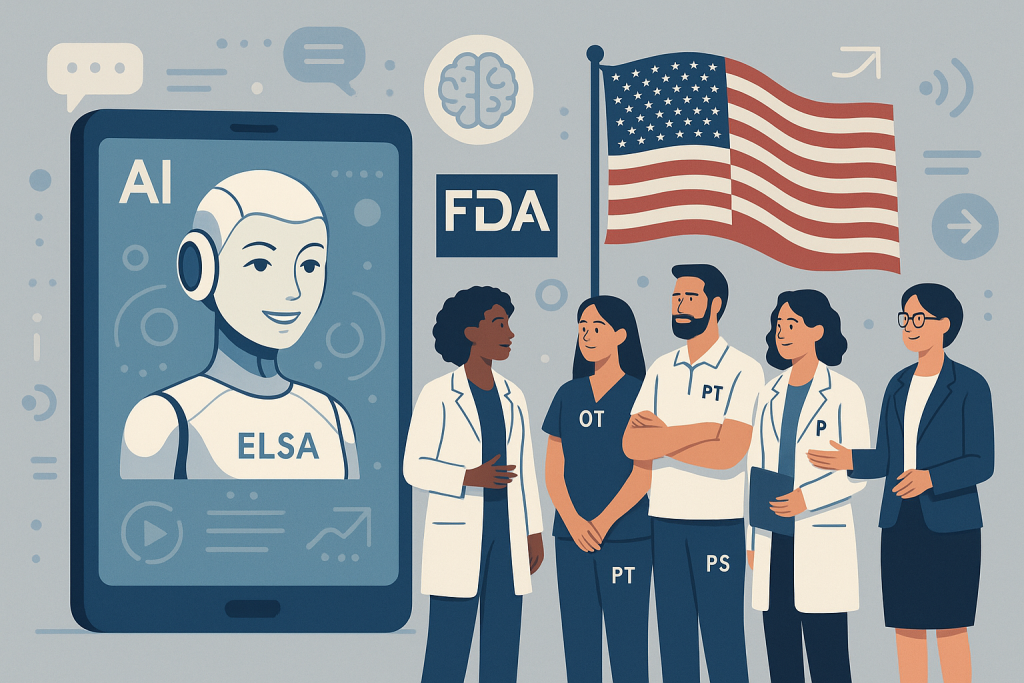
AI’s Leap from Hype to Healthcare Standard
Artificial intelligence (AI) is no longer just an emerging concept—it’s now a regulated, practical tool in healthcare. In 2025, regulatory bodies and professional organizations are setting clear expectations for AI’s role in clinical practice. These changes are especially relevant for speech-language pathologists (SLPs), occupational therapists (OTs), physical therapists (PTs), psychologists, and psychomotor therapists, many of whom are already using AI-powered tools in therapy. Two recent events—the FDA’s launch of Elsa, its first agency-wide AI tool, and the AMA’s call for “explainable AI”—are now shaping how therapists approach AI in daily practice.
Elsa: The FDA’s New AI Tool
The U.S. Food and Drug Administration (FDA) has launched Elsa, a generative AI tool designed to modernize internal workflows. Built on a large language model and deployed within a secure GovCloud environment, Elsa helps FDA staff read, write, summarize, and analyze data-heavy documents. Elsa does not train on industry-submitted data, protecting proprietary and sensitive information (FDA, 2025a).
Elsa’s functions include summarizing adverse event reports, accelerating clinical protocol reviews, automating label comparisons, generating code for internal databases, and identifying priority inspection targets. Tasks that once took days can now be completed in minutes, freeing staff for higher-level evaluations (FDA, 2025b). Elsa’s successful, ahead-of-schedule rollout is a real-world example of how AI can handle administrative complexity while maintaining high standards of security and reliability (Hogan Lovells, 2025).
The AMA and Explainable AI
Alongside Elsa’s debut, the American Medical Association (AMA) has introduced new guidance emphasizing “explainable AI.” This means AI systems must clearly articulate how they arrive at specific recommendations, predictions, or alerts (Healthcare Brew, 2025). For therapists, this is crucial: explainability ensures clinicians can interpret AI-generated insights, communicate them transparently to clients and families, and make informed decisions rooted in professional accountability.
AI in Physical Therapy: Real-Time, Personalized, and Predictive Care
AI is fundamentally transforming physical therapy, making rehabilitation smarter, faster, and more accessible. Here’s how:
- Real-Time Motion Analysis:
AI-powered systems use sensors and cameras to track patient movements during therapy sessions, providing immediate feedback and comparing performance to healthy benchmarks. This helps PTs design personalized rehabilitation exercises, correct form in real time, and reduce the risk of future injuries (ShadhinLab, 2025; SPRY PT, 2025). - Wearable Devices and Remote Monitoring:
Wearables equipped with AI track activity levels, gait, posture, and range of motion, allowing PTs to monitor progress both in the clinic and remotely. These devices send alerts for incorrect movements and help ensure adherence to home exercise programs, improving engagement and outcomes (ShadhinLab, 2025; Net Health, 2024). - Predictive Analytics and Outcome Tracking:
AI analyzes vast amounts of patient data to predict recovery trajectories and potential setbacks. For example, it can identify if a patient recovering from knee surgery is at risk of reinjury, enabling PTs to proactively adjust treatment plans (ShadhinLab, 2025; EmpowerEMR, 2025). - AI-Enhanced Documentation and Administration:
AI automates documentation, scheduling, and billing, capturing clinical notes during sessions and reducing paperwork. This allows PTs to focus more on patient care and less on administrative tasks (EmpowerEMR, 2025; Net Health, 2024; SPRY PT, 2025). - Advanced Human Movement Analysis:
Tools like LinedanceAI use video data and advanced algorithms to precisely identify and quantify movement deficits, supporting more accurate diagnosis and targeted interventions. This technology enables continuous monitoring and real-time adjustments to therapy protocols (Business of AI in Healthcare, 2024). - Immersive and Data-Driven Rehabilitation:
AI-powered virtual reality and robotic-assisted therapy are creating interactive, motivating recovery experiences that can be personalized to each patient’s needs, both in the clinic and at home (SPRY PT, 2025).
Best Practice Recommendations for PTs and All Therapists
- Prioritize Explainable, HIPAA-Compliant Tools: Choose platforms that provide clear insight into how decisions are made and protect patient privacy.
- Maintain Clinical Judgment: Use AI to support—not replace—your expertise. Always review and adapt AI-generated suggestions within your therapeutic framework.
- Engage Patients and Families: Explain how AI tools work and involve patients in decision-making to build trust and foster collaboration.
- Stay Current: Follow evolving standards from the FDA, AMA, and your professional association to ensure ethical and effective AI integration.
Conclusion: A Turning Point in Physical Therapy and Beyond
Elsa’s launch and the AMA’s new standards mark a significant shift in how AI is integrated into therapy and healthcare. For physical therapists, AI now offers real-time analysis, personalized care, predictive insights, and streamlined operations—enhancing outcomes while upholding the human connection at the heart of therapy. By selecting explainable, privacy-conscious tools and applying clinical reasoning, PTs and all therapists can safely integrate AI as a trusted partner in modern rehabilitation.
References
American Psychological Association. (2025, January). Harnessing the power of artificial intelligence.
Business of AI in Healthcare. (2024, August 13). AI in physical therapy: Human movement analysis.
EmpowerEMR. (2025, February 12). Artificial intelligence in physical therapy: Impact & applications.
FDA. (2025a, June 2). FDA launches agency-wide AI tool to optimize performance for the American people.
FDA. (2025b, June 3). FDA launches “Elsa” AI tool to aid drug approvals.
Healthcare Brew. (2025, June 24). AI 411: June 2025.
Hogan Lovells. (2025, June 12). FDA launches “Elsa” AI tool to aid drug approvals.
Net Health. (2024, October 21). AI in physical therapy: The future of operations and patient care.
Sali, S., Mavani, R., & Kaelin, M. (2025). Revolutionizing rehabilitation: How artificial intelligence is shaping the future of occupational therapy. Florida Occupational Therapy Association.
ShadhinLab. (2025, March 3). How AI in physical therapy is transforming rehabilitation in 2025.
SPRY PT. (2025, June 20). 2025 advancements in physical therapy: AI, VR & robotic tech.
University of St. Augustine for Health Sciences. (2025, April). AI for speech therapy: Enhancing speech-language pathology training.
